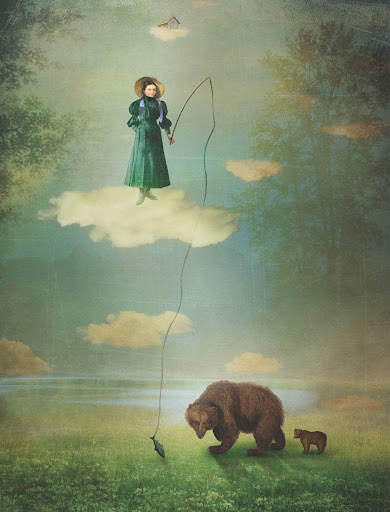I have always been a great builder of castles in the air.
My Year 5 teacher would, without any warning, rap my head with a ruler, saying, ‘are you with us, Katie?’ I’d jump like a startled rabbit, jerked back into the ordinary world. The dazed expression on my face made everyone around me giggle. I’d shrink back in my chair, bewildered and humiliated.
I couldn't help being a daydreamer. Something – a word, a picture, an association - would spark a train of thought, a chain of images, a quick firing of nerve impulses in my brain. The real world faded to black, and the imaginary world quickened with life. I would not even be aware that I had drifted away. Time seemed to fold its wings, and minutes passed like seconds.
Daydreaming has long been viewed as a waste of time, a sign of laziness and lack of focus, even a symptom of dangerous neurotic disturbance.
I have long argued that, to the contrary, daydreaming is a crucial function of a creative and innovative mind. I tell my writing students that they must make space and time for daydreaming every day. I beg teachers not to mock or punish the wool-gatherers in their classes. It is the day-dreamers of this world who will create something great, I tell them. They are the ones who will invent something extraordinary, the ones who are best equipped to solve the world’s problems.
I speak from a passionately held belief inspired by my own personal experience, yet recent research into the neurology of creativity supports me resoundingly.
The human brain has been called the most complex object in the known universe ...and it remains one of the most mysterious.
In a single brain, there are about 86 billion neurons, or ‘brain cells’. These are electrically excitable cells that process and transmit information to up to 10,000 other neurons at a time, via as many as one thousand trillion synaptic connections, at the speed of one-five-hundredth of a second.
These connected neurons are called neural networks, and they grow and change and adapt and wither and die. With each new experience and with each remembered event, the brain rewires its physical structure. So the more we think, the more we imagine, the stronger and more complex our neural networks become.
The brain is vast enough to contain the whole of a person’s life, encoded and folded into the soft grey tissues, and yet the brain is small enough to be carried in two cupped hands. I find that beautiful and astonishing.
‘When we daydream, we're at the centre of the universe,’ neurologist Marcus Raichle of Washington University said in a 2014 interview in Scientific American. Raichle believes we have a dedicated daydreaming network deep in our brain, which he has dubbed the ‘default mode network’.
It consists of three main regions: the medial prefrontal cortex, the posterior cingulate cortex and the parietal cortex. The first helps us imagine the thoughts and feelings of others; the second draws on personal memories and experiences; and the third is connected to the hippocampus which stores episodic memories in bright and involuntary flashes.
Basically, the ‘default mode network’ is where the brain goes to when the hyper-alert focused state of conscious directed thinking switches off. Our mind drifts. Thoughts and ideas and images flow through our mind’s eye in a loosely connected stream-of-consciousness. This state-of-mind is characterised by a fluid and non-linear mode of thinking that makes unexpected connections and intuitive leaps that can lead to sudden and unexpected epiphanies of understanding.
‘Yet it is in our idleness, in our dreams,’ Virginia Woolf wrote, ‘that the submerged truth sometimes comes to the top.’
The brains of most people, it has been posited, return to the default mode for almost half of our waking hours. Daydreaming is, therefore, an entirely natural and necessary state of consciousness.
Not all daydreaming is beneficial, of course.
Fifty-two years ago, the American psychologist Jerome L. Singer published an intensely personal account of his years of studying undirected thought in The Inner World of Daydreaming (1975). He divided daydreams into three distinct categories: ‘positive-constructive’, in which individuals imagined happy scenarios of success and triumph for self-amusement and comfort, or used the free-ranging thought state to creatively solve problems; ‘dysphoric’, in which the thinker is tortured by anxieties, regrets or visions of failure and grief; and ‘poor attentional control’ in which the individual finds it hard to focus at all.
Most people experience all three kinds to some degree. The term ‘maladaptive daydreaming’ has been coined to describe those whose daydreaming falls into the second category to such an extent that it interferes with their ability to function within society. Most people would call that ‘Walter Mitty Syndrome’, after the title character in James Thurber’s 1939 short story (which has since inspired two popular films).
For most people, though, daydreaming allows us to delve deep into the unconscious mind and make wonderful and serendipitous discoveries. For some of us, it is an irreplaceable part of our creative process. I daydream on purpose. I let my mind drift where it will, even if it throws up monsters of the deep, and I wait for that moment of sudden and exceptional clarity, that moment of epiphany where I suddenly understood what had been obscure and incomprehensible moments before.
Edgar Allan Poe said, ‘Those who dream by day are cognizant of many things which escape those who dream only by night.’
For me daydreaming is a kind of meditation, but I do not aim to empty my mind of all thought. I simply try to think freely, without restraint. It is not entirely undirected thought. If I find myself obsessing too much about food or fashion or the stupid thing I blurted out over cocktails the night before, I gently try to redirect my thoughts. I try to be open and sensitive and curious to the world, even while I allow that world to fade away. I am what Singer called ‘a happy daydreamer’.
Yet, when I am writing, I enter a state of intense mental focus. Words flow through my fingers and onto the page. I am totally engaged, totally mindful. Psychologists call this state ‘meta-awareness.’
Instinctively I feel that this meta-awareness arises from the practise of mindfully switching between the outer and inner streams of consciousness. Between hyper-focused concentration and free-drifting daydreaming.
In ‘The Wandering Mind: What Your Brain Does When You’re Not Looking’ (2015), Michael Corballis, Professor Emeritus at Auckland University, writes: ‘(day-dreaming) has many constructive and adaptive features … it includes time travel – the wandering back and forth through time, not only to plan our futures based on past experiences but also to generate a continuous sense of who we are. Mind-wandering allows us to inhabit the minds of others, increasing empathy and social understanding. Through mind-wandering, we invent, tell stories, expand our mental horizons. Mind-wandering underwrites creativity, whether as a Wordsworth wandering lonely as a cloud or an Einstein imagining himself travelling on a beam of sunlight.’
Daydreaming does all this for me, and more. But I feel I must leave the last word to Anne of Green Gables, who I have always loved because she – like me – was a daydreamer.
‘It's really splendid to imagine you are a queen. You have all the fun of it without any of the inconveniences and you can stop being a queen whenever you want to, which you couldn't in real life.’
http://www.womankindmag.com/articles/daydreaming-creativity/








